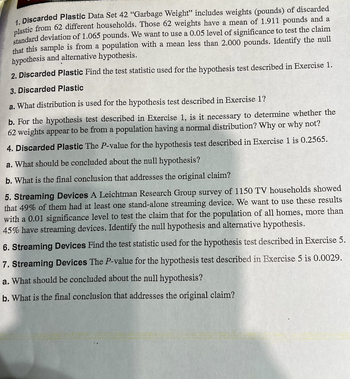
MATLAB: An Introduction with Applications
6th Edition
ISBN: 9781119256830
Author: Amos Gilat
Publisher: John Wiley & Sons Inc
expand_more
expand_more
format_list_bulleted
Question
i would love to check my answers and diagrams to these if possible! thanks!

Transcribed Image Text:**Exercise 1: Discarded Plastic**
*Data Set 42 "Garbage Weight"* includes weights (pounds) of discarded plastic from 62 different households. Those 62 weights have a mean of 1.911 pounds and a standard deviation of 1.065 pounds. We want to use a 0.05 level of significance to test the claim that this sample is from a population with a mean less than 2.000 pounds. Identify the null hypothesis and alternative hypothesis.
1. **Discarded Plastic**
2. **Discarded Plastic**
*Find the test statistic used for the hypothesis test described in Exercise 1.*
3. **Discarded Plastic**
a. What distribution is used for the hypothesis test described in Exercise 1?
b. For the hypothesis test described in Exercise 1, is it necessary to determine whether the 62 weights appear to be from a population having a normal distribution? Why or why not?
4. **Discarded Plastic**
*The P-value for the hypothesis test described in Exercise 1 is 0.2565.*
a. What should be concluded about the null hypothesis?
b. What is the final conclusion that addresses the original claim?
**Exercise 5: Streaming Devices**
A Leichtman Research Group survey of 1150 TV households showed that 49% of them had at least one stand-alone streaming device. We want to use these results with a 0.01 significance level to test the claim that for the population of all homes, more than 45% have streaming devices. Identify the null hypothesis and alternative hypothesis.
6. **Streaming Devices**
*Find the test statistic used for the hypothesis test described in Exercise 5.*
7. **Streaming Devices**
*The P-value for the hypothesis test described in Exercise 5 is 0.0029.*
a. What should be concluded about the null hypothesis?
b. What is the final conclusion that addresses the original claim?

Transcribed Image Text:**6. Streaming Devices**
Find the test statistic used for the hypothesis test described in Exercise 5.
**7. Streaming Devices**
The P-value for the hypothesis test described in Exercise 5 is 0.018.
a. What should be concluded about the null hypothesis?
b. What is the final conclusion that addresses the original claim?
Expert Solution
This question has been solved!
Explore an expertly crafted, step-by-step solution for a thorough understanding of key concepts.
This is a popular solution
Trending nowThis is a popular solution!
Step by stepSolved in 2 steps with 1 images

Knowledge Booster
Similar questions
- The sum of two numbers is 22 and their product is -48. Let x = one of the numbers. Identify all the statements below that are correct.arrow_forwardthe answer that is provided is not correct all of them except number 1. Can you please try to do it again.arrow_forwardPlease refer to image and answer!arrow_forward
arrow_back_ios
SEE MORE QUESTIONS
arrow_forward_ios
Recommended textbooks for you
 MATLAB: An Introduction with ApplicationsStatisticsISBN:9781119256830Author:Amos GilatPublisher:John Wiley & Sons Inc
MATLAB: An Introduction with ApplicationsStatisticsISBN:9781119256830Author:Amos GilatPublisher:John Wiley & Sons Inc Probability and Statistics for Engineering and th...StatisticsISBN:9781305251809Author:Jay L. DevorePublisher:Cengage Learning
Probability and Statistics for Engineering and th...StatisticsISBN:9781305251809Author:Jay L. DevorePublisher:Cengage Learning Statistics for The Behavioral Sciences (MindTap C...StatisticsISBN:9781305504912Author:Frederick J Gravetter, Larry B. WallnauPublisher:Cengage Learning
Statistics for The Behavioral Sciences (MindTap C...StatisticsISBN:9781305504912Author:Frederick J Gravetter, Larry B. WallnauPublisher:Cengage Learning Elementary Statistics: Picturing the World (7th E...StatisticsISBN:9780134683416Author:Ron Larson, Betsy FarberPublisher:PEARSON
Elementary Statistics: Picturing the World (7th E...StatisticsISBN:9780134683416Author:Ron Larson, Betsy FarberPublisher:PEARSON The Basic Practice of StatisticsStatisticsISBN:9781319042578Author:David S. Moore, William I. Notz, Michael A. FlignerPublisher:W. H. Freeman
The Basic Practice of StatisticsStatisticsISBN:9781319042578Author:David S. Moore, William I. Notz, Michael A. FlignerPublisher:W. H. Freeman Introduction to the Practice of StatisticsStatisticsISBN:9781319013387Author:David S. Moore, George P. McCabe, Bruce A. CraigPublisher:W. H. Freeman
Introduction to the Practice of StatisticsStatisticsISBN:9781319013387Author:David S. Moore, George P. McCabe, Bruce A. CraigPublisher:W. H. Freeman

MATLAB: An Introduction with Applications
Statistics
ISBN:9781119256830
Author:Amos Gilat
Publisher:John Wiley & Sons Inc

Probability and Statistics for Engineering and th...
Statistics
ISBN:9781305251809
Author:Jay L. Devore
Publisher:Cengage Learning

Statistics for The Behavioral Sciences (MindTap C...
Statistics
ISBN:9781305504912
Author:Frederick J Gravetter, Larry B. Wallnau
Publisher:Cengage Learning

Elementary Statistics: Picturing the World (7th E...
Statistics
ISBN:9780134683416
Author:Ron Larson, Betsy Farber
Publisher:PEARSON

The Basic Practice of Statistics
Statistics
ISBN:9781319042578
Author:David S. Moore, William I. Notz, Michael A. Fligner
Publisher:W. H. Freeman

Introduction to the Practice of Statistics
Statistics
ISBN:9781319013387
Author:David S. Moore, George P. McCabe, Bruce A. Craig
Publisher:W. H. Freeman